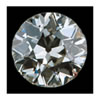 The old European cut is considered the father of the present round brilliant cut. The old European cut was more evident in the late eighteenth century till the early twentieth century. Many experiments were done on the old European cut during the early twentieth century regarding its various facet positioning and angles. Most notable were the cutting styles created by Henry Morse and Marcel Tolkowsky. They ultimately gave birth to the present round brilliant cut and the ideal cut diamond proportions.
The old European cut is considered the father of the present round brilliant cut. The old European cut was more evident in the late eighteenth century till the early twentieth century. Many experiments were done on the old European cut during the early twentieth century regarding its various facet positioning and angles. Most notable were the cutting styles created by Henry Morse and Marcel Tolkowsky. They ultimately gave birth to the present round brilliant cut and the ideal cut diamond proportions.
 An old European cut diamond is an old style of faceting a diamond in a round shape, hand worked, in a less than perfect fashion. This style enabled the diamonds 58 facets to show broader reflective bands of brilliance returning back up through the top portion of the diamond (the table facet). Old European cut diamonds continued the characteristic of the old cuts with their open culet and higher crown. It is similar to the old mine cut, but is round rather than squarish and has 58 facets.
An old European cut diamond is an old style of faceting a diamond in a round shape, hand worked, in a less than perfect fashion. This style enabled the diamonds 58 facets to show broader reflective bands of brilliance returning back up through the top portion of the diamond (the table facet). Old European cut diamonds continued the characteristic of the old cuts with their open culet and higher crown. It is similar to the old mine cut, but is round rather than squarish and has 58 facets.
 The old European cut did not require the use of a diamond saw in fabrication, so until that piece of equipment was perfected, this cut along with the old mine cut were the standards in diamond cutting. Although few contemporary cutters use these facet designs, you will still see them commonly in antique and estate jewelry. These cuts follow the original shape of the rough, and are therefore usually heavy and deep and may have poor symmetry.
The old European cut did not require the use of a diamond saw in fabrication, so until that piece of equipment was perfected, this cut along with the old mine cut were the standards in diamond cutting. Although few contemporary cutters use these facet designs, you will still see them commonly in antique and estate jewelry. These cuts follow the original shape of the rough, and are therefore usually heavy and deep and may have poor symmetry.
 While being cut with less than exacting proportions, these diamonds have a beauty and magic of their own which give them a desirable, distinct beauty just as the bygone era in which they were fashioned. This cutting style began to disappear around the turn of the century.
While being cut with less than exacting proportions, these diamonds have a beauty and magic of their own which give them a desirable, distinct beauty just as the bygone era in which they were fashioned. This cutting style began to disappear around the turn of the century.

